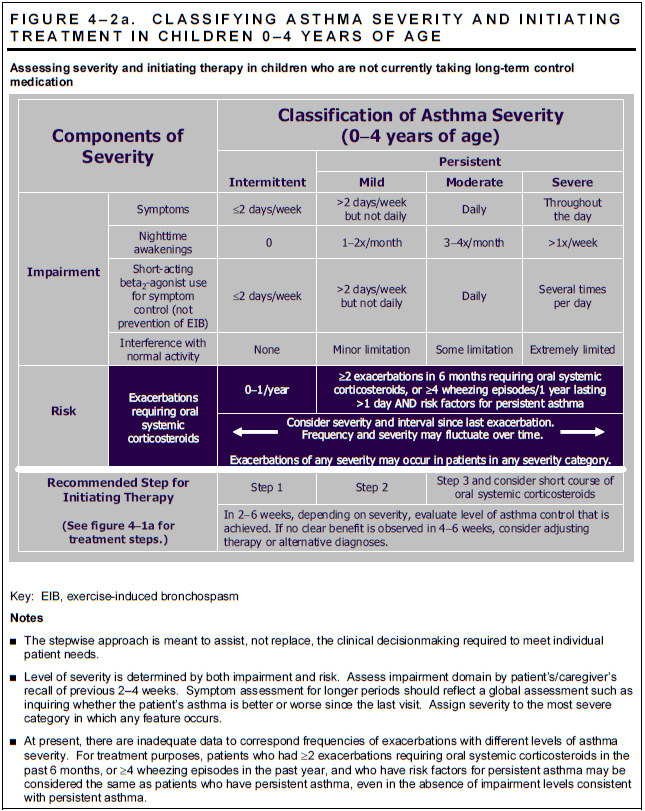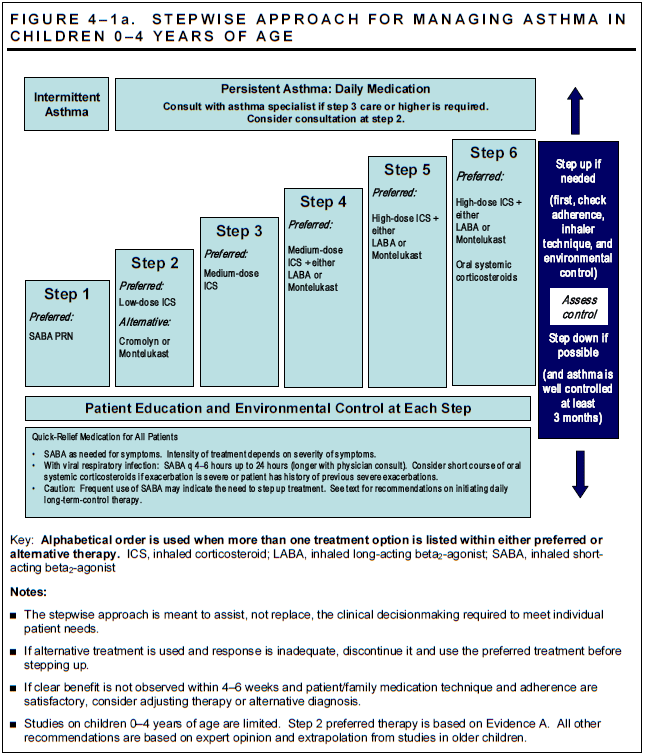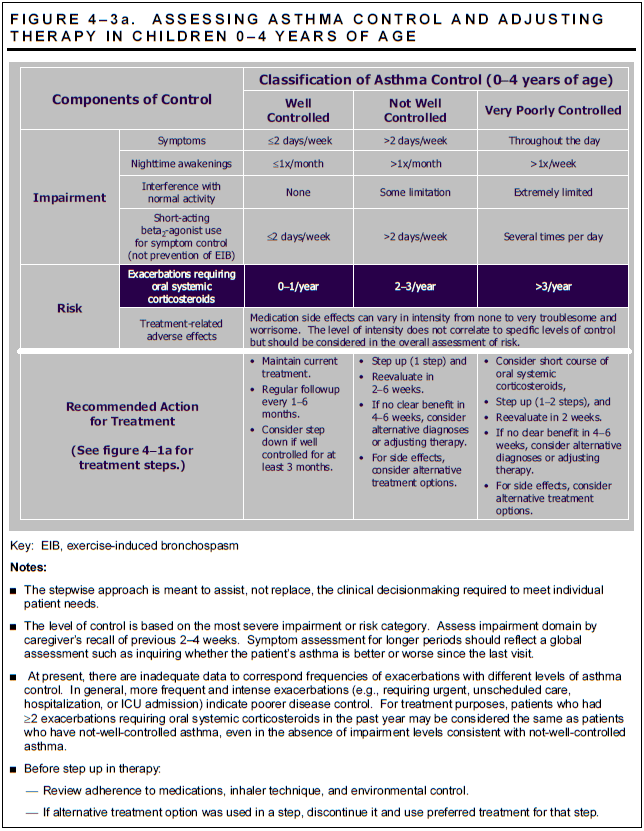Asthma Classification and Management For Infants and Small Children
Under Age 5

Classifying Asthma Severity in Children
The functions of assessment and monitoring are closely linked to the concepts of severity, control, and responsiveness to treatment:
- Severity: the intrinsic intensity of the disease process. Severity is most easily and directly measured in a patient who is not receiving long-term control therapy. Severity can also be measured, once asthma control is achieved, by the step of care (i.e., the amount of medication) required to maintain control.
- Control: the degree to which the manifestations of asthma are minimized by therapeutic intervention and the goals of therapy are met.
- Responsiveness: the ease with which asthma control is achieved by therapy.
Asthma severity and asthma control include the domains of current impairment and future risk.
- Impairment: frequency and intensity of symptoms and functional limitations the patient is currently experiencing or has recently experienced.
- Risk: the likelihood of either asthma exacerbations, progressive decline in lung function (or, for children, reduced lung growth), or risk of adverse effects from medication.
The concepts of severity and control are used as follows for managing asthma:
- Assess severity to initiate therapy. During a patient's initial presentation, if the patient is not currently taking long-term control medication, asthma severity is assessed to guide clinical decisions for initiating the appropriate medication and other therapeutic interventions.
- Assess control to adjust therapy. Once therapy is initiated, the emphasis for clinical management thereafter is changed to the assessment of asthma control. The level of asthma control will guide decisions either to maintain or to adjust therapy (i.e., step up if necessary, step down if possible).

|

|
- For mild asthma, no daily medication is needed. However, the use of short-acting ß2-agonist more than two times per week may indicate the need to start long-term control medication.
- For mild persistent asthma, one daily long-term control medication (inhaled corticosteroids are preferred therapy) is necessary.
- For moderate persistent asthma, inhaled corticosteroids with or without additional long-term control medications are indicated.
- For severe persistent asthma, multiple long-term control medications are required, including high-dose inhaled corticosteroids and, if needed, oral corticosteroids.
|

|
|
Treating Children Under Age 5 for Asthma
With an accurate diagnosis and classification, the child's asthma can then be managed using best practices and a stepwise approach. Learn more about the asthma medications referred to on this page.
|
| Well Controlled |
Not Well Controlled |
Very Poorly Controlled |
| Maintain current step |
Step up 1 step and reevaluate in 2-6 weeks |
Consider short course of oral corticosteroids |
Consider step down if well controlled
for at least 3 months |
For side effects, consider alternative treatment options |
Step up 1-2 steps and reevaluate in 2 weeks
For side effects, consider alternative treatment options
|
|
Quick-Relief for All Patients
Bronchodilator as needed for symptoms: Short-acting inhaled ß2-agonist by nebulizer (0.05 mg/kg in 2-3 cc of saline) or inhaler with face mask and spacer (2-6 puffs; for exacerbations, repeat every 20 minutes for up to 1 hour).
With Viral Respiratory Infection
The Expert Panel recommends the following actions for managing exacerbations due to viral respiratory infections, which are especially common in children. These exacerbations may be intermittent yet severe.
- If the symptoms are mild, short-acting inhaled ß2–agonists (every 4–6 hours for 24 hours, longer with a physician consult) may be sufficient to control symptoms and improve lung function. If this therapy needs to be repeated more frequently than every 6 weeks, consider a step up in long-term care.
- If the viral respiratory infection provokes a moderate-to-severe exacerbation, a short course of oral systemic corticosteroids should be considered (1 mg/kg/day prednisone or equivalent for 3–10 days).
- For those patients who have a history of severe exacerbations with viral respiratory infections, consider initiating oral systemic corticosteroids at the first sign of the infection.
- Referral to an asthma specialist for consultation or co-management if patient requires step 3 for children 0–4 years of age. Consider referral if patient requires step 2 for children 0–4 years of age.
Learn when to refer patients to an asthma specialist.
Poor Asthma Control
1. Assess Reasons for Poor Asthma Control – ICE
- Inhaler technique – Check patient's technique.
- Compliance – Ask when and how much medication the patient is taking.
- Environment - Ask patient/parent if something in his or her environment has changed.
Is there environmental tobacco smoke in the home? Find out about cotinine levels, which can help track exposure to tobacco smoke and its toxic constituents using a saliva, blood or urine test.
You may also want to consider an alternative diagnosis. Assess patient for presence of other upper respiratory disease or alternative diagnosis. 2. Consider Increasing Long-Term Medications
It may be necessary to increase anti-inflammatory medication to regain control of a patient's asthma. Please see "Assessing Asthma Control and Adjusting Therapy in Children 0 – 4 Years of Age" for more information.
Medication Delivery in Young Children
Medication delivery devices should be selected based on the child's ability to use them well.
Nebulizer therapy is one option for administering short-acting inhaled ß2-agonists or inhaled corticosteroids in children. A metered-dose inhaler (MDI) with a spacer/valved-holding chamber that has a face mask may also be used to take inhaled steroids. MDI plus spacer/valved-holding chamber may be used by many children of this age. If the desired therapeutic effects are not achieved, a nebulizer or an MDI plus spacer/valved-holding chamber with a face mask may be required. An MDI plus spacer/valved-holding chamber is as effective as nebulizer for delivering short-acting inhaled ß2-agonists in mild to moderate exacerbations; data in severe exacerbations are limited.
|